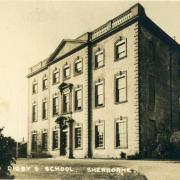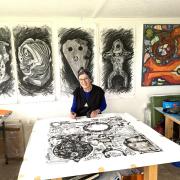The much-loved book series Horrible Histories is celebrating its 30th anniversary and Dorset-based illustrator Martin Brown has been drawing all its ghastly gory historic moments since it started.
The most memorable episodes in human history are written in blood, guts and gore; just ask any kid. It's a truism that author Terry Deary has been demonstrating in spectacular fashion for 30 years since the first volume of Horrible Histories was published in 1993. With more than 30 million book sales in some 30 different languages, Deary has been dubbed the most influential historian of our times and for three decades his closest partner in grime has been illustrator Martin Brown.

‘It's still mind blowing when you think about it,’ says the amiable Aussie over a hearty lunch at his local, the reliably excellent Anchor Inn at Shapwick; the village has been home to Martin, wife Sally and their daughters Emily and Bella for the best part of 25 years.
‘It started with four people sat at a table - Terry and I, an editor and art director - scribbling notes and doodling and making each other laugh. And now we're marking the 30th anniversary by doing things like spending the best part of two days getting to and from Manchester to do seven minutes on the BBC Breakfast sofa - like that's just what you do.’ he laughs. ‘How did that happen?’
It happened because, with its trademark blend of facts and jokes (and a fair bit of poo!), Horrible Histories is among the most successful franchises in modern publishing. The first books followed the National Curriculum and established a style that runs throughout more than 70 titles, as well as magazines, audio books, television series, stage shows, physical and video games, all manner of merchandise and the 2019 feature film Horrible Histories: The Movie - Rotten Romans.

This year saw the publication of another compilation, The Worst in the World packed with gold, silver and bronze entries for the most horrible of everything in history. It was met with rave reviews and sales to match demonstrating that the appetite for such deviously educational antics is as ravenous as ever.
‘It just keeps on going,’ sighs Martin. ‘In one sense we've created a monster and now we must feed it, but there have been times when we've thought it was coming to an end, only for it all to get going again. And it's international. For instance, Lithuania was taking every title - I can understand Rotten Romans and Groovy Greeks, but Slimy Stuarts?
‘When people ask about why it works, our semi-serious answer is that Terry is accused of being the historian, and I'm accused of being the illustrator; but really, Terry is a storyteller and I'm a cartoonist. Terry brings historical facts and stories to life; I write gags and draw funny pictures,’ Martin grins. ‘I can't pretend it's not fun because it is!’

These days, the Horrible Histories franchise requires a team of people to take care of the sheer volume of creative work. Blandford-based comics artist Rob Davis adds the colour, and illustrator Mike Phillips finishes the line work on some of Martin's drawings; most recently for Horrible Histories: Ghosts - ‘frightful stories behind iconic ghost tales and legends from around the world’, and Horrible Histories: On the Road - ‘foul facts behind the story of cars and automobiles across the world’.
‘They're steeped in the Horrible Histories style so that removes any sense of 'marking' someone else's work,’ explains Martin. ‘Because Rob works digitally it means that when, say, we need a set of figures for a game or something on TV we've already got digital files they can work with.
‘I could work on Horrible Histories all day every day for the rest of the year and still not get it all done. So, I'll probably do something most days - I'm going to start on some roughs today. There are things that I can't talk about, but we've done a few city books in the past, and new ones are on the way; maybe we should do some county books as well?’

Horrible Histories: Crackin' Castles book features both Maiden Castle and Corfe Castle, so watch this space. Surely there's no shortage of horrible history fodder in deepest darkest Dorset to work with. When asked in a recent Q & A, which era he would like to visit, Martin plumped for the Middle Ages in London or Corfe Castle, so long as he could travel with a good dentist.
However, central to Martin's sense of all being right with the world is that he has creative outlets other than Horrible Histories. Forget Newt Scamander’s Fantastic Beasts and Where to Find Them, Martin Brown has real beasts and where to find them filling two volumes of Lesser Spotted Animals which illuminate such brilliant animals as the zorilla, Altai argali, Ili pika and numbat – real creatures great and small that are routinely overshadowed by more familiar fauna. ‘How can you help protect these creatures if we don't even know it exists?’ he questions.
Lesser Spotted Animals was followed by his first venture into fiction, Nell and the Cave Bear and its sequel Nell and the Cave Bear: The Journey Home that came out in March this year.

‘Nell came from an idea I had for a graphic novel-style picture book that told the story of the Stone Age through the eyes of a little girl. Eventually it became clear that her story was more interesting than the history. My friend, the totally amazing children's author Angela McAllister, who lives in Shaftesbury, encouraged me to expand the story with words since I had already plotted everything pictorially.
When it came to the illustrations Martin drew on familiar Dorset locations that he knew well. ‘Some of the river and beach scenes were inspired by kayaking on the Stour near Shapwick, and the wonderful beach and dunes at Studland. In the second book, The Journey Home, one of the character’s tumbledown shack is set ‘high on the dunes among a few spiky shrubs and wind-twisted trees’ and comes straight from my memories of summer days on the beach, and long winter dog walks at Studland Bay.
He really enjoyed writing both books and would love to do another. It’s clear that after 30 years of illustrating Horrible Histories, as well as his own creative projects, Martin is still as enthused by drawing.
‘I’ll be 64 this year,’ he admits. ‘My dad was retired by this age, but no matter how much I think I like the ideas of days off or weekends away, I'm not done yet; there's loads more I want to do.’
Martin Brown’s Lesser Spotted Animals Volumes 1 & 2, Nell and The Cave Bear and Nell and The Cave Bear: The Journey Home are available to buy from Martin’s website
martinbrownillustrator.co.uk

Ahead of our meeting Martin set what sounded like a simple enough task: draw a horse from memory, then straight after draw another horse after looking at photographs for reference.
Over our pie and a pint at the Anchor, I showed him my drawings. I thought they were shocking, convinced that I cannot draw.
‘Except that you can,’ says Martin. ‘You've drawn a recognisable horse. Twice.’ he adds, with a degree of kindness. ‘The second looks more like a real horse because you looked at a picture of a horse before you drew it. Drawing realistically is no more than transferring what you see from your eye to the page.’
It turns out there is no magic wand or mystical skill that can be imbued to make you good at drawing. You may have a flair for it, but as Martin explains, as with so many things in life, it is all about technique and practice. Lots of practice. But the practice, says Martin, can be a lot of fun.
‘We do plenty of things badly because we enjoy them. I'm rubbish at dancing but I love it. This evening, I’ll join a group of middle-aged blokes to scuttle around the basketball court doing an impression of playing five-a-side football - we do it because it's a hoot, not because any of us plays like Ronaldo.
‘You can have fun playing three chords on a guitar, if you enjoy it then you learn to play more. Talent only comes into it when you're right at the top, it's that tiny bit extra that makes the very best even better.’
So, how has Martin turned making lines on pieces of paper into such successful career? It all started with a teach yourself to draw book, published in 1939, that his mum gave him.
‘I was largely self-taught, most of what I know came from that book; it takes you from drawing a wobbly circle on day one to showing you how to make complex drawings that show reflections on an ellipse for instance - tricky stuff,’ he smiles, adding that other books and art teachers helped him to hone his skills. ‘When I was young, I drew like everyone else - badly drawn aeroplanes and faces - but as I loved drawing so much, I kept going, and developed a vague ambition to make a living at it.’
Finally, how about a little encouragement for us undisciplined doodlers? Does he really think anyone can draw?
‘Drawing is good for our wellbeing because it makes us better at looking. Eyes are powerful things.
‘When I'm asked to give talks about drawing, and it's aimed at the dads, I ask them to promise me that the next time they're on holiday, to take ten minutes and look at the view from the hotel room balcony or wherever and draw it. I guarantee it will be tosh – boats like bathtubs, people will be little stick things, the perspective will be off. Then I tell them to put that drawing in a drawer. In five time, when it surfaces again, looking at it will bring back that view in every detail because rather than just taking a quick snap with your phone, you really looked.’
You can find some excellent draw-a-long with Martin Brown videos on YouTube covering everything from drawing faces and animals to Rotten Romans.
Horrible Histories: The Worst in the World by Terry Deary with illustrations by Martin Brown is published by Scholastic at £7.99




























